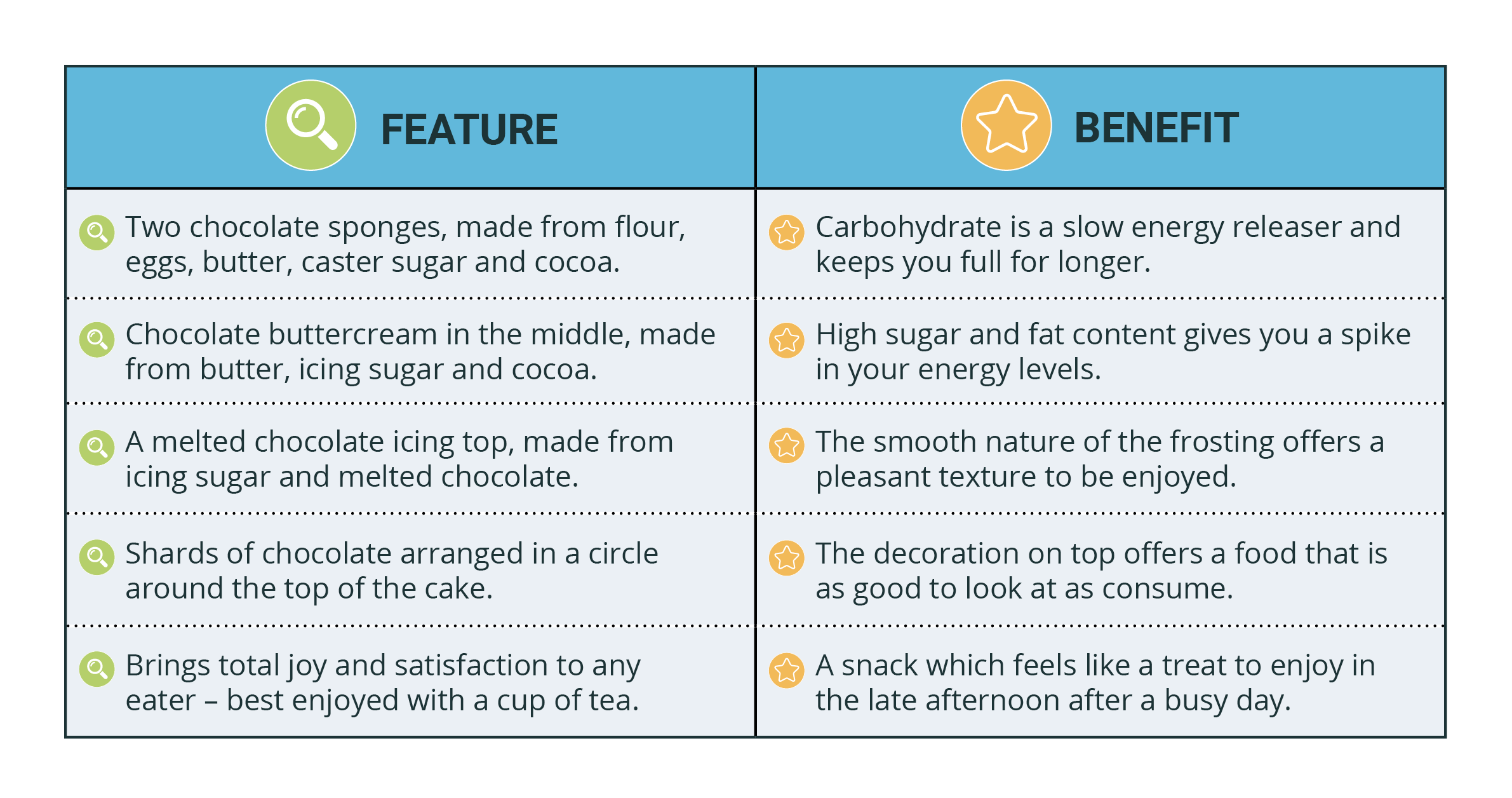In an overcrowded world, how do you make your voice heard above the noise of competing products? Unique benefits. You need to help prospects understand why your product stands out over another, whether that be personalisation, simplicity or originality.
Here we explore three ways to highlight the benefits of your product or service to your audience, as explored in a recent The Guardian Masterclass we attended, led by Eddy Lawrence. Here we’ll pass on the key takeaways we learnt to help your audience choose your offering over other options and seek a future in which your product is positively changing their life.
Tip 1: Know the difference between features and benefits
Remember when your high school teachers taught you to read the question carefully in exams? Understanding your features and benefits is very similar to this skill (see – all those exams would come in handy later in life, after all!) There will be times your audience needs to understand a product’s features, and other times, they need to be told the product’s benefits: you have to read them very carefully in order to identify which they need from you and when.
Activity:
What are the physical properties of your product or service? How would you describe it to someone who’s never seen it before? Make a list of every single feature your product has. For example:
My product: a chocolate cake

Features:
- Two chocolate sponges, made from flour, eggs, butter, caster sugar and cocoa.
- Chocolate buttercream in the middle, made from butter, icing sugar and cocoa.
- A melted chocolate icing top, made from icing sugar and melted white chocolate.
- Shards of dark chocolate arranged in a circle around the top of the cake.
- It brings total joy and satisfaction to any eater – best enjoyed with a cup of tea.
(Anyone else’s mouth watering? Maybe we chose the wrong example…)
As Eddy Lawrence explained during our masterclass:
“Clearly explaining the features of your product shows you have mastery and confidence in your ability to write about it. You’re leaving no stone unturned and being totally upfront about your product’s capabilities. Being able to explain what your product is – and is not – shows an openness and willingness to share, as well as a secure command of its potential.”
In order to explain the benefits of your product to your prospective customer, you must first outline the features.
Activity:
Make a list of every single benefit of someone using your product or service. What pain points does it sooth? What problems are solved by it? For example:
Benefits:
- It tastes delicious which is an enjoyable experience.
- Endorphins are released, helping the consumer feel happy, relaxed and less stressed.
- It fills you up so prevents unpleasant pangs of hunger.
- Its high fat and sugar content helps the eater feel as if they are having a treat since this isn’t the kind of food we should frequently consume.
- Helps you put on weight if you’ve been told you need to do so.
Now try to match a benefit to each of your features, so you can see how each feature might be isolated and explored in further detail with your customer. This allows you to give your audience specific, targeted knowledge about your product, without overwhelming them by looking at the whole package:

This activity means that, no matter what question a prospect might ask you about your product, you’ll have a specific benefit already outlined to support the feature, turning functional questions into benefits-driven answers. Promote the part of the product that will appeal to your buyer persona, not the whole package: make it as easy as possible to understand your product and digest its separate parts.
Tip 2: Know the difference between wants and needs
Needs are, by their very nature, necessary and basal. They’re the things we require in day to day life to survive such as food, shelter and rest. Wants are the “nice to haves” of life – the enjoyable bonuses and pleasures.
Consumers don’t actually want to be told about things they need, they want to be told more about the things they want – these are the benefits to focus on.
So why do people want to buy products that tap into their wants, rather than needs?
- Needs remind people of their responsibilities and obligations – things that tie us down.
- Needs also remind people of the rules – certain things about society and their lives that can’t be changed and restrict them.
- Needs remind us of things we can and can’t do with our futures and the confines in which we operate.
- Whereas wants play on our vanities – they show us a version of ourselves as we want to be in the future.
- Wants uncover our ambitions and show us the best version of ourselves.
- Wants are fun, feel more rebellious and indulgent.
It’s all about how you show your prospect their potential, as Eddy Lawrence explains during his masterclass:
“By targeting your buyer persona’s wants more than their needs, you show them an aspirational version of themselves – a self without responsibilities, away from the humdrum of everyday life. You need to transport them to a future where your product makes them a fun, successful and happy version of themselves.”
The secret is to encourage prospective customers to associate your product with positive benefits, rather than mundane, everyday chores. Plus, people are more likely to make happy financial decisions based on wants, whereas buying “needs” can lead to reluctance and resentment.
Is choice always a good thing?
Many brands pride themselves on the sheer volume of features and benefits they offer to consumers; one pen knife might do 50 different things, offering the user endless options for its use. Personalisation is more important than ever in the modern world of buying, too: if your product has customisable options, then you’ll be keen to promote them. From mobile phones to mugs, tailoring is important to customers – it helps us show off our exclusivity and gain status among our peers.
The mentality here is that, if your product does everything and yet feels customised to you, the customer won’t have any reason to look elsewhere for a competitor’s alternative.
But a product that ‘does everything’ can be overwhelming. If your product does so many different things that it requires a customer to read a 150-page manual in order to get started, it can have the opposite effect and put people off. People don’t like to feel like they don’t know what they’re doing, or need to commit a lot of time to a task.
It might sound counteractive, but sometimes people like to know they have the ‘standard’ product. No choice and no freedom means no confusion. It’s been proven that limited choice – especially on things such as menus – actually makes people happier.
Depending on your audience – and if you’ve accurately identified your buyer personas you’ll understand this – you’ll either want to promote the variety and personalisation of your product, or alternatively, promote its simplicity and straightforwardness: it depends on who you’re speaking to.
Tip 3: Know how to argue and counter argue
In order to fully explore the benefits of your product, you need to know how to counter argue anyone who doubts your capabilities or compares you to an alternative option. By identifying your product’s primary flaw – working out what the biggest argument is against your product – you can pre-empt how consumers might convince themselves not to use it and prepare a counter argument before they turn away.
Activity:
What are the top three benefits of your product? For example, if we go back to the chocolate cake analogy, we might decide that the three biggest benefits are:
- It tastes delicious and thus brings joy to the consumer
- It’s a beautifully presented snack so is a joy to look at
- It makes the consumer feel happy and as though they are having a treat.
Now cut this list down to the top one – this is your primary argument.
- It makes the consumer feel happy and as though they are having a treat.
What are the three biggest arguments against your product? For example:
- It’s unhealthy for the body if consumed too often, and will make you fat
- It might make you feel sluggish when the sugar rush wears off
- You can eat a lot of other delicious food for the same calories as a cake slice.
Now cut this list down to the top one (the most common resistance people make towards your product):
- It’s unhealthy for the body if consumed too often, and will make you fat
Come up with a logical and convincing response to this concern – this is your primary counter argument.
- Everything in moderation is healthy – a piece of cake here and there as a treat actually does the body and mind good, instead of consistently depriving yourself.
Now, when writing about your product, you can focus your content on this primary argument and counter argument.
Top tip:
To effectively cement yourself in the consciousness of your reader, repeat these points at least 3 times during your content writing – not close together, but throughout the whole piece of content.
It’s important to still mention secondary and tertiary benefits, to give the primary one a break and keep your reader engaged, but ensure you repeat the most important benefit three times (it’s a magic number) in a piece of content.
If you know how to effectively communicate the benefits of your products to your audience, visitors can become prospects, and prospects will become customers. If you try to skip a step – such as forgetting to outline the features – or overwhelm a customer – such as giving sweeping overviews of benefits instead of focusing on them individually in line with the features – you will confuse and potentially lose your audience. Try these three different approaches and clarify your product, elevating it above competitors.
Stay Updated with Our Latest Insights
Get expert HubSpot tips and integration strategies delivered to your inbox.




